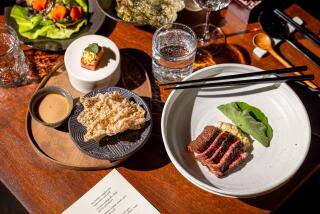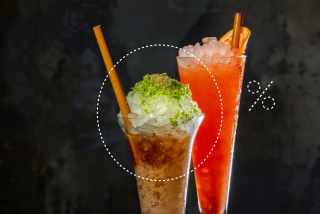Women find a place in the craft cocktail movement
The soul of the electric-green apple martini has been shaken, not stirred. The same holds true for traditional gender roles in the city’s bars.
The craft cocktail movement of the last four years has been something of a breakthrough. Before the current craze for reimagining classic drinks using house-made ingredients, women were a common sight working in lounges but often in a different capacity, says cocktail consultant Aidan Demarest.
“Women were prevalent up and down Sunset [Boulevard]. Beautiful girls in miniskirts and half-shirts is what you hired,” he says.
But today, the sight of a woman drizzling aromatic basil oil into a gin drink or rinsing a martini glass with absinthe has become increasingly common. As bartending takes on the status of a chef-like career, more women are taking the position of authority behind the bar.
“It’s like with any industry, women are often underrepresented,” Tricia Alley, 36, says from her post behind the intimate bar at Eva restaurant, where she has been experimenting with five-spice bitters she cooked up in her home kitchen.
Alley has been in the hospitality industry for 17 years, but it wasn’t until she started working with another prominent female mixologist, Zahra Bates, five years ago at a bar in Westlake Village that she began to fully grasp the possibilities of a craft cocktail career.
“Zahra came along and told me I wasn’t crazy,” recalls Alley of what she refers to as her “geeky” interest in technique and the classic recipes popularized by the legendary 19th century bartender Jerry Thomas. (He’s considered the great-grandfather of the current movement.) “And I was the only one who didn’t think she was crazy, until she worked with Vincenzo Marianella.”
Marianella, who mixes at Copa d’Oro in Santa Monica, is often credited with spearheading the L.A. scene. Like Bates, he tended bar in London in the early aughts, when that city was considered the cocktail capital of the world. He was already back in L.A. when Bates, 39, left her post at the Long Bar inside London’s five-star Sanderson Hotel to return to the city where she started her career, at age 22, at Bar Marmont.
In 2008, Bates and Marianella teamed up as a cocktail consulting business called MyMixology. Now, Bates, who administers the cocktail program at Michael Cimarusti’s seafood restaurant Providence, is considered one of the top mixologists in the city by many of her peers.
Lately, Bates has been experimenting with making what she calls cocktail amuses-bouche: A toasted marshmallow on a stick infused with the ingredients for an Old-Fashioned instead of water; Pimm’s liquor boiled down into caviar-like beads to put in Champagne; and a fascinating creation in a shot glass that she calls “the cheese course” made with amaretto, passion fruit and Parmesan espuma (foam) and rimmed with a touch of crunchy salt and pepper.
“This season, I was really getting into lighting things on fire,” says Bates, laughing. “I think because of the cold.”
Her fascination with the culinary aspect of drink-making is shared by her compatriots. Alley, who was recently tapped to manage the cocktail program at Hollywood’s new Rolling Stone restaurant, even penned a mission statement for herself in 2007 called “The Era of the Cocktail Chef.”
“We don’t eat like our parents anymore. We’re more sophisticated. We don’t serve canned beans in restaurants anymore. It’s the same with cocktails,” she says, adding a note that is also true of how the bars are staffed: “And now that we’re here, we’re not going backwards.”
“Making cocktails was the first American culinary art,” says Eric Alperin, the man behind one of the city’s most renowned craft cocktail bars, the Varnish. He’s referring to the way the trade’s early adherents experimented with available fruits, herbs and spices to create new forms of libation. “I’ve worked with women who have culinary backgrounds who have taken to making cocktails quite seamlessly.”
Demarest, who helped launch some of the city’s most notable mixology programs, including those at First & Hope, 1886 and, most recently, the Spare Room at the Hollywood Roosevelt Hotel, takes Alperin’s thought a step further.
“It added a sensibility to the bar that women can bring. Guys don’t generally have an herb garden at home or put on an apron and cook up some bitters on their day off,” Demarest says.
At the Spare Room, a bar with two bowling lanes and a ritzy but relaxed clubhouse feel, Demarest has four women working for him, including two highly regarded mixologists: Jennifer Contraveos, who made a name for herself in Chicago before coming to L.A., and Naomi Schimek.
Schimek, who was raised in a log cabin in Vermont, has an encyclopedic knowledge of fresh herbs and grows ingredients for her aromatic cocktails in her home garden. It’s a skill she honed under the guidance of Manhattan cocktail maven Audrey Saunders at the Tar Pit (before Saunders departed), then at First & Hope, where she trained under Demarest and his partner, mixologist Marcos Tello, as part of the pair’s cocktail consulting firm Tello Demarest Liquid Assets.
“Right now, I’m excited about planting for spring,” says Schimek, who speaks with a gently lilting voice. “I’m planting sloe berries for the first time. I want to approximate a sloe gin liqueur.”
Also on Schimek’s agenda: foraging for wild fennel on Mt. Hollywood after a good rain to make something interesting with gin; hiking in Malibu “where there are no dogs,” to gather dandelions to make “some dandelion wine like my grandmother used to make”; making jasmine sugar with fresh jasmine blooms; candying borage flowers (“the leaves have a nice cucumber flavor”); and teaching herself how to plate cocktails like “you would plate an entrée or dessert.”
Other women shaking up the city’s craft cocktail scene include Rachel Shaw, who once oversaw the beverage program at Malo; Nikki Sunseri, the hard-working talent behind the booze program at Little Dom’s and Dominick’s; Danielle Crouch at Caña Rum Bar and the Tar Pit; Brent Falco, who heads up the Red Car bar at Cole’s; and the Varnish’s Devon Tarby, who trained under Alperin after starting there at the door and working her way up. She’s currently the only woman behind the bar at the Varnish.
Alperin says it’s his intention to eventually train all his cocktail waitresses to be bartenders. The idea is that there is no job beneath any employee. Ideally, each member of the staff should know how to host, work the floor, barback and bartend. That’s hospitality, he says.
This practice will inevitably lead to even more women behind the bar, which suits Alperin just fine.
“A feminine sensibility is important,” he says. “There’s a sensitivity that is different in women. Can I put my finger on it? No. But I like it.”
More to Read
The biggest entertainment stories
Get our big stories about Hollywood, film, television, music, arts, culture and more right in your inbox as soon as they publish.
You may occasionally receive promotional content from the Los Angeles Times.







